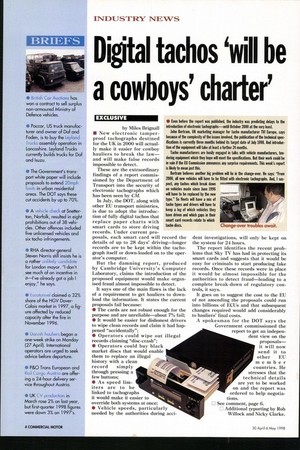Digital tachos 'will be a cowboys' charter' by Miles Brignall
Page 5

If you've noticed an error in this article please click here to report it so we can fix it.
• New electronic tamperproof tachographs destined for the UK in 2000 will actually make it easier for cowboy hauliers to break the law— and will make false records impossible to detect.
These are the extraordinary findings of a report commissioned by the Department of Transport into the security of electronic tachographs which has been seen by CM.
But the damning report, produced by Cambridge University's Computer Laboratory, claims the introduction of the proposed equipment would make organised fraud almost impossible to detect.
It says one of the main flaws is the lack of a requirement to get hauliers to download the information. It states the current proposals fail because: • The cards are not robust enough for the purpose and are unreliable—about 7% fail; • It would be easier for dishonest drivers to wipe clean records and claim it had happened "accidentally"; • Vehicle speeds, particularly needed by the authorities during acci dent investigations, will only be kept on the system for 24 hours.
The report identifies the recent problems that Sky TV has had in protecting its smart cards and suggests that it would be easy for criminals to start producing fake records. Once these records were in place it would be almost impossible for the authorities to detect fraud—leading to a complete break-down of regulatory controls, it says.
It goes on to suggest the cost to the EU of not amending the proposals could run into billions of ECUs and that subsequent changes required would add considerably to hauliers' final costs.
A spokesman for the DOT says the Government commissioned the report to get an indepen dent view on the proposals— See comment, page 6.
LI Additional eporting by Rob Willock and Nicky Clarke.























































































































